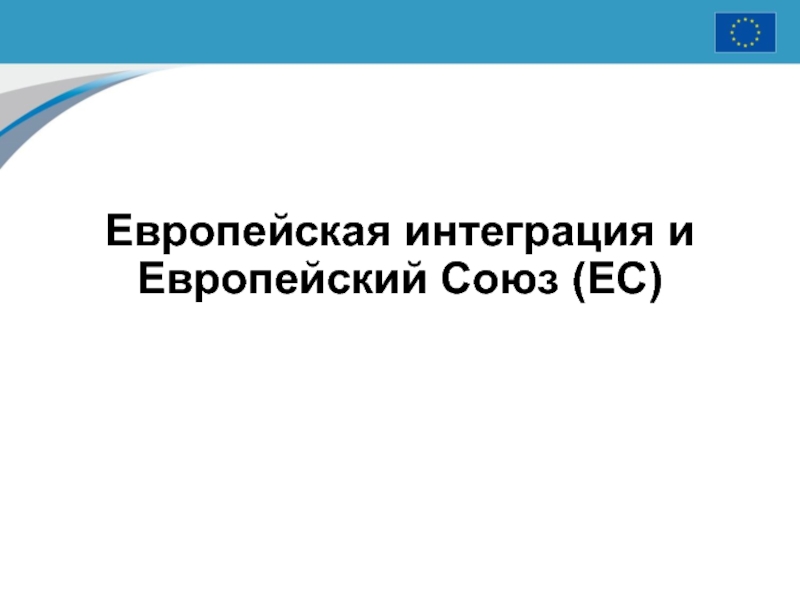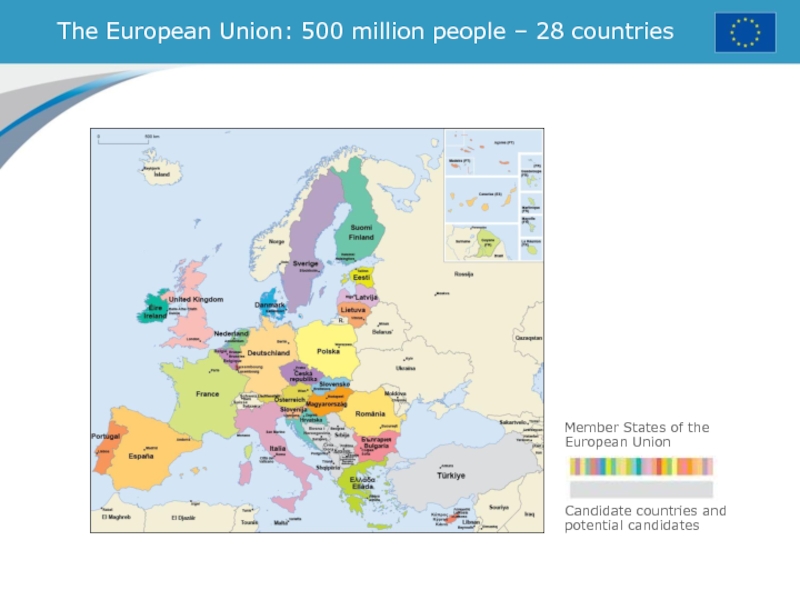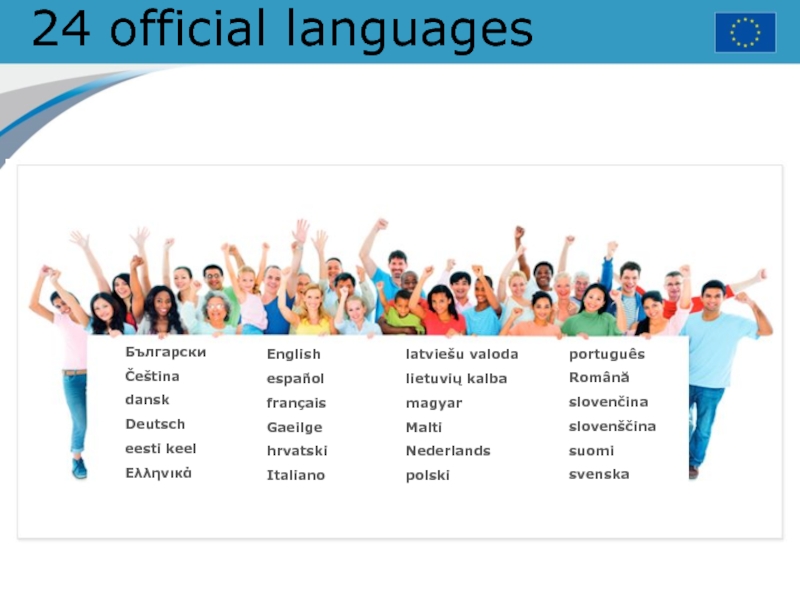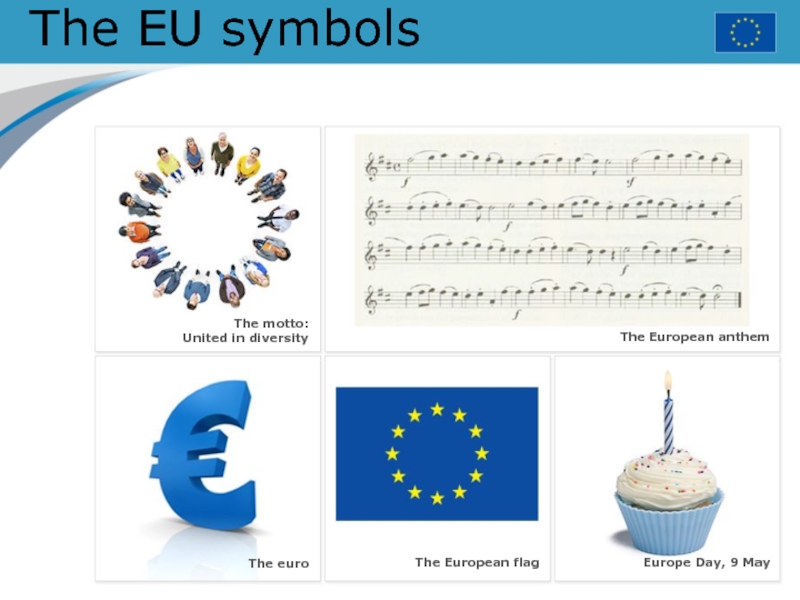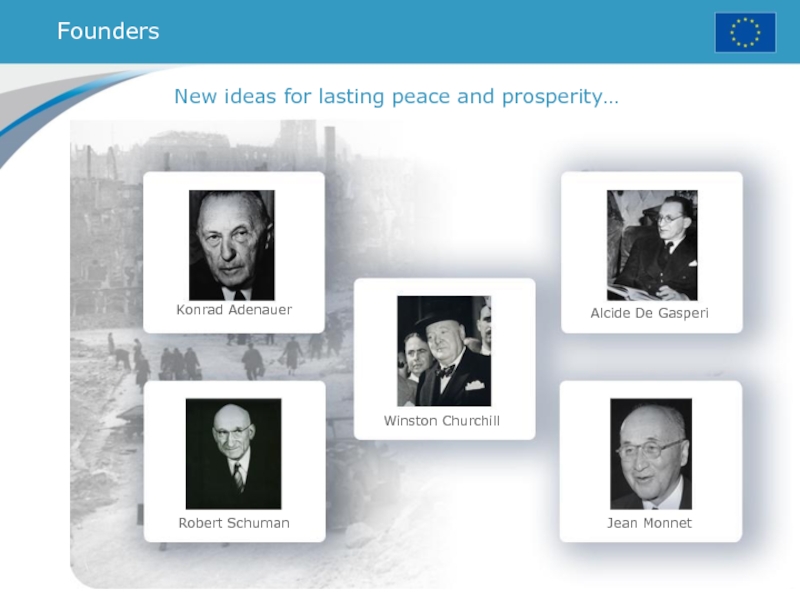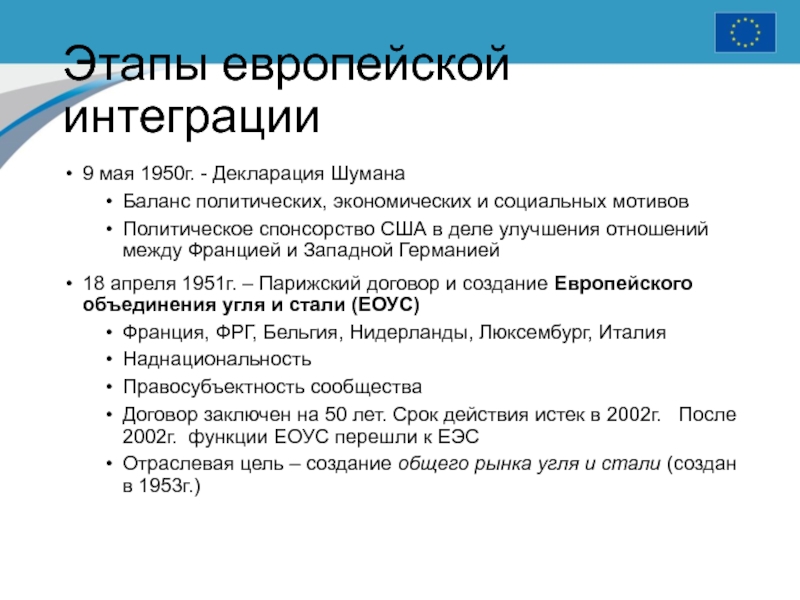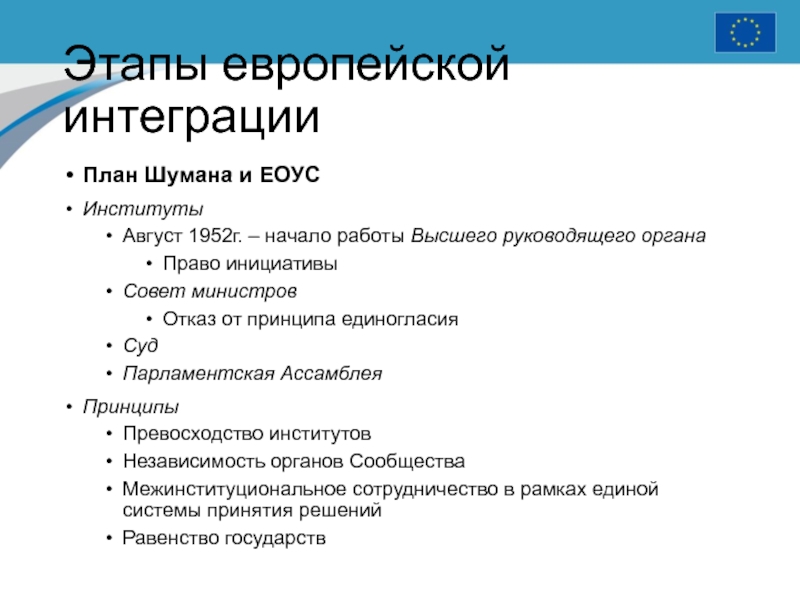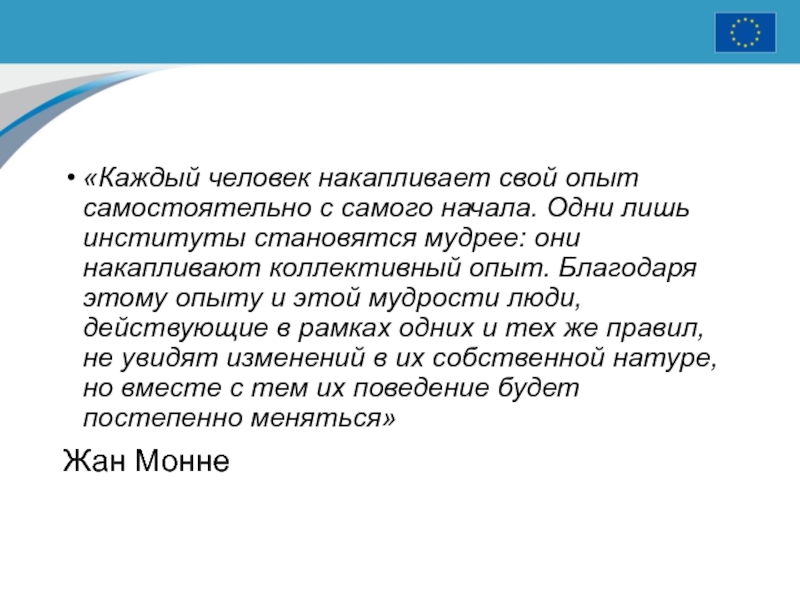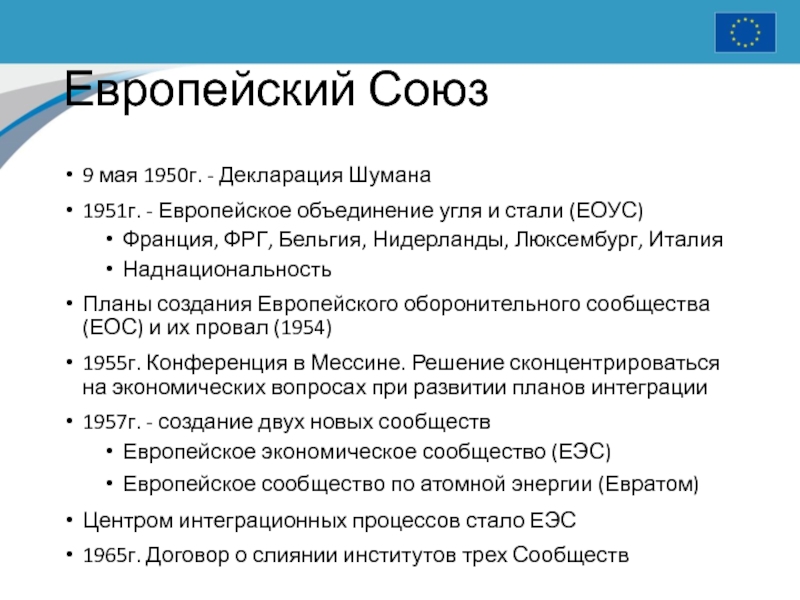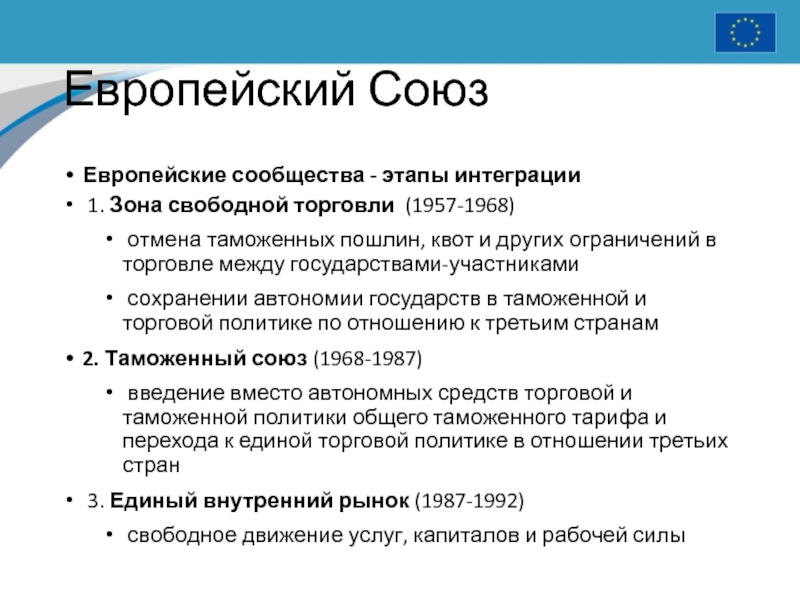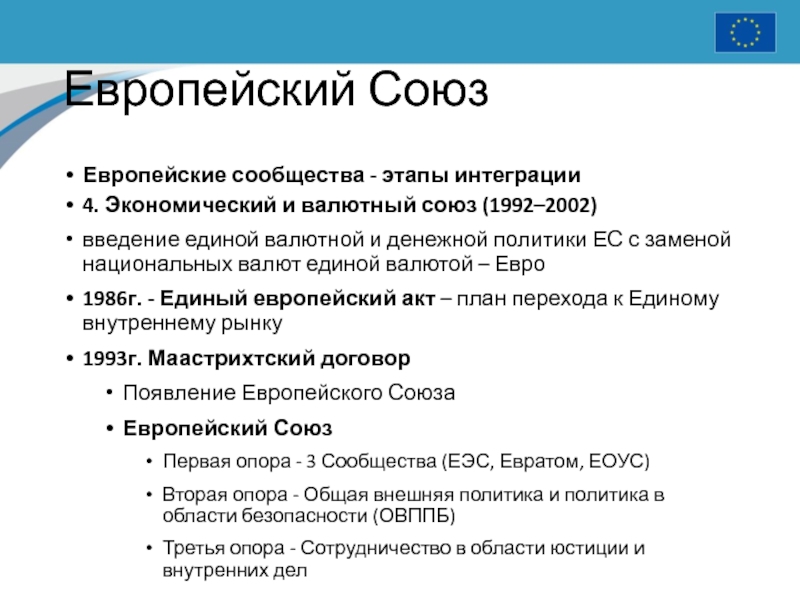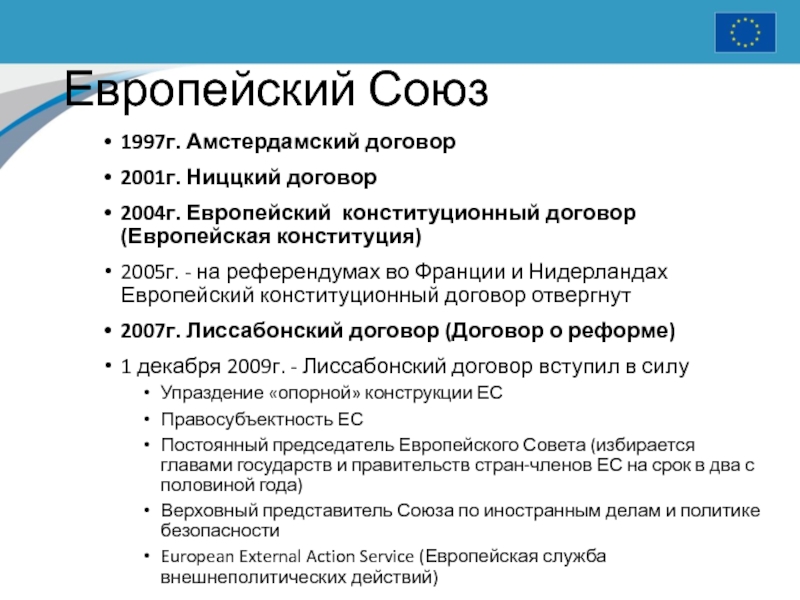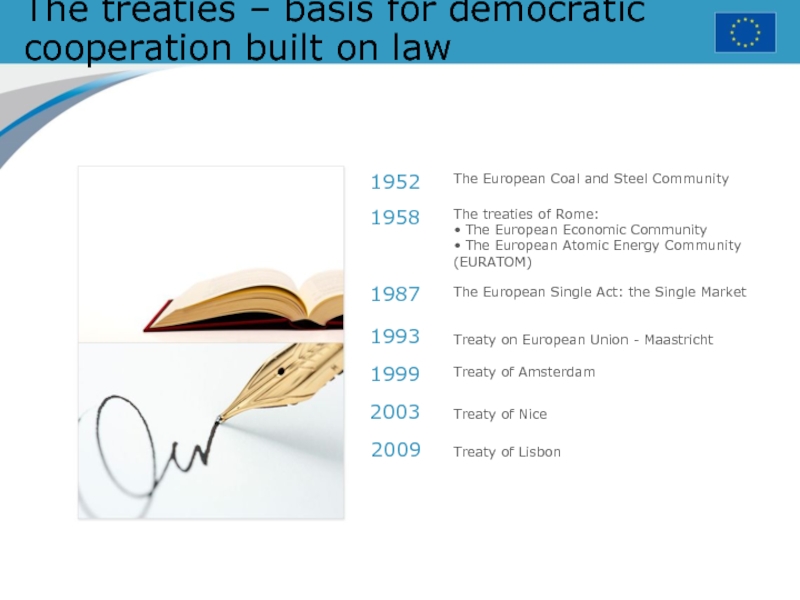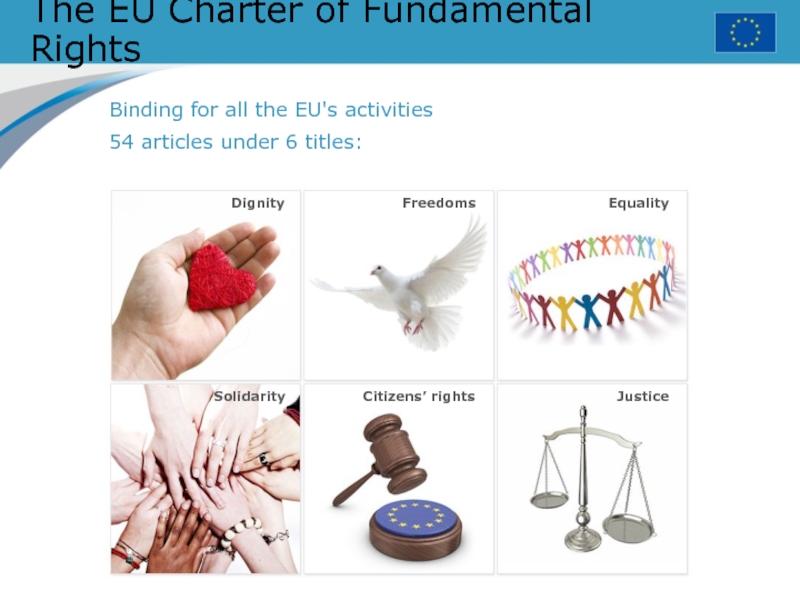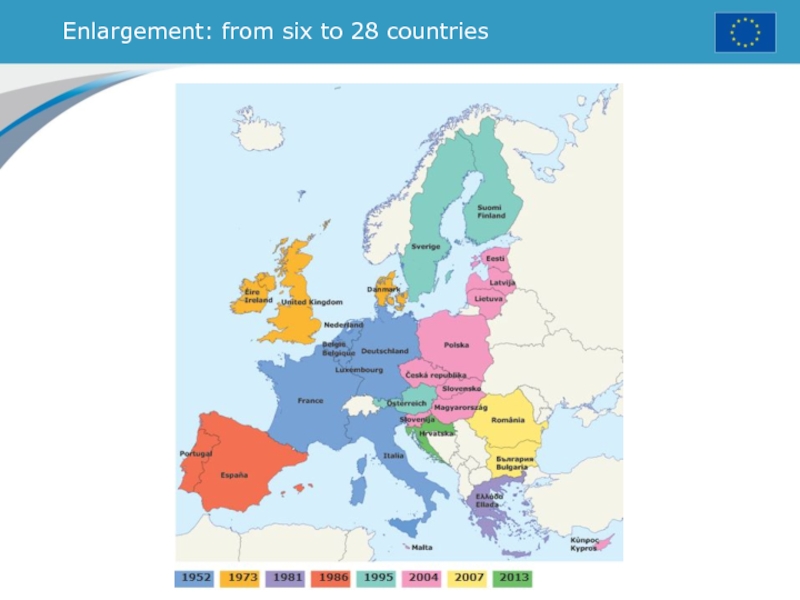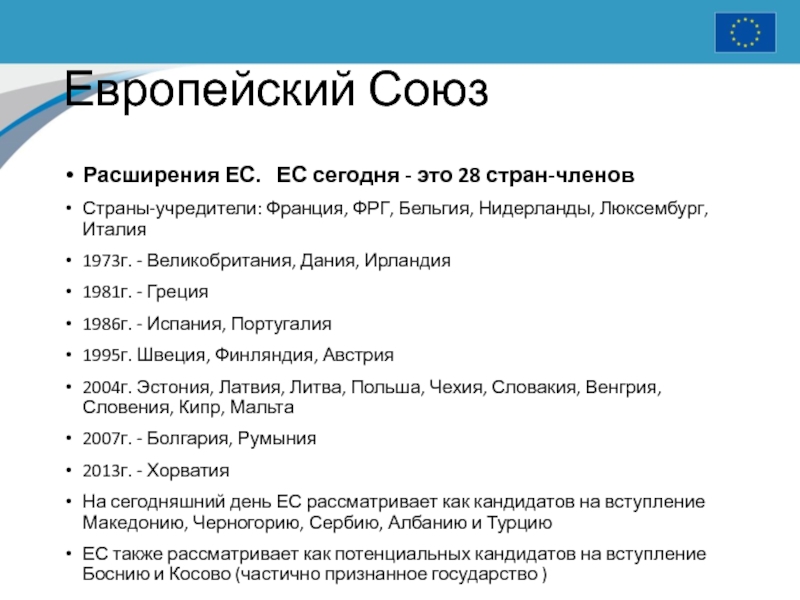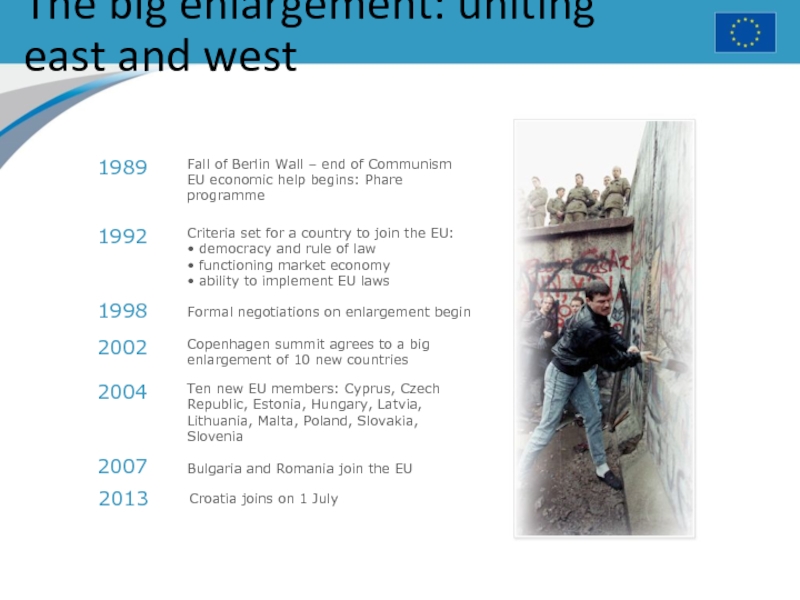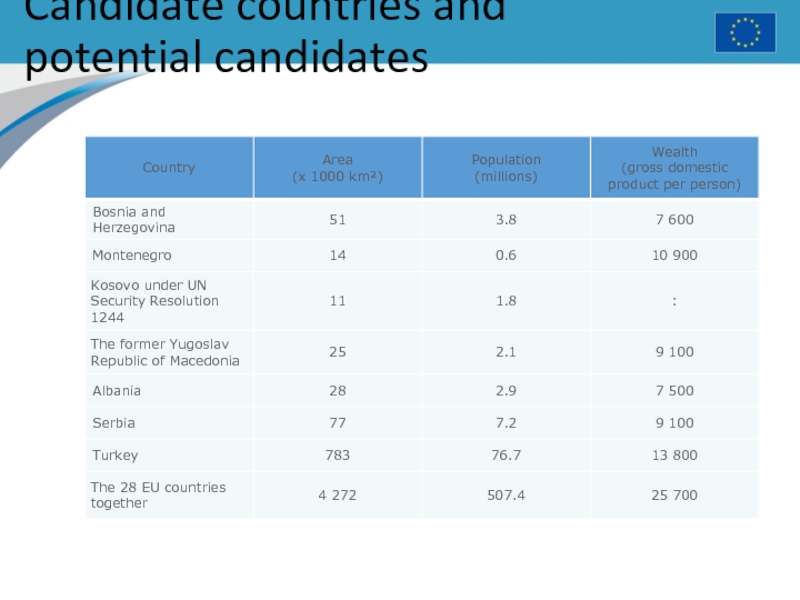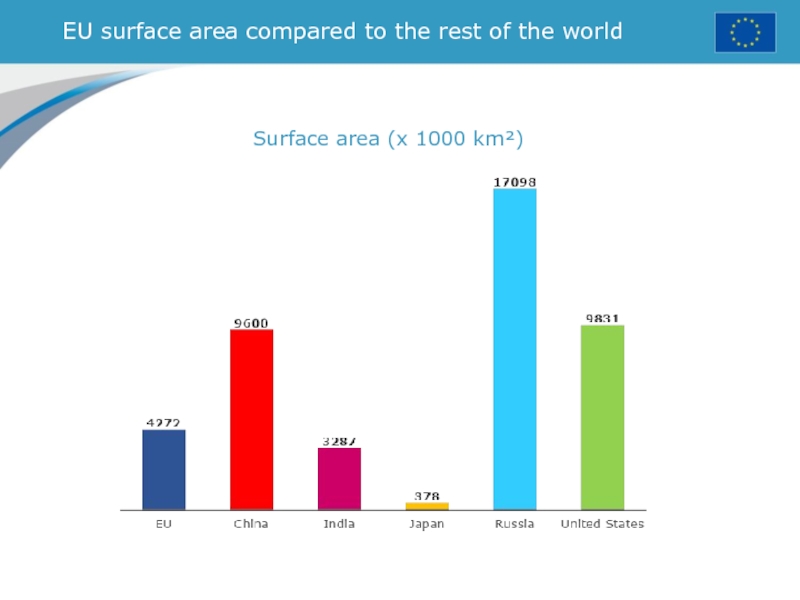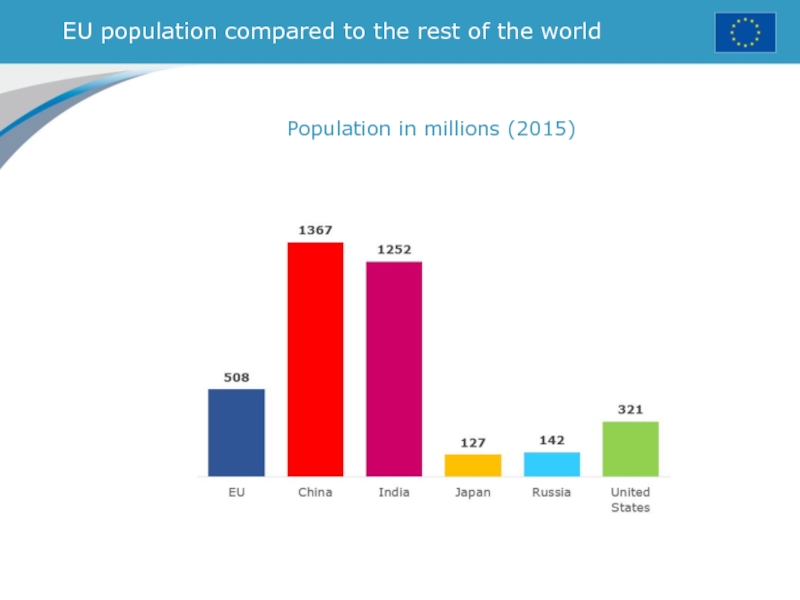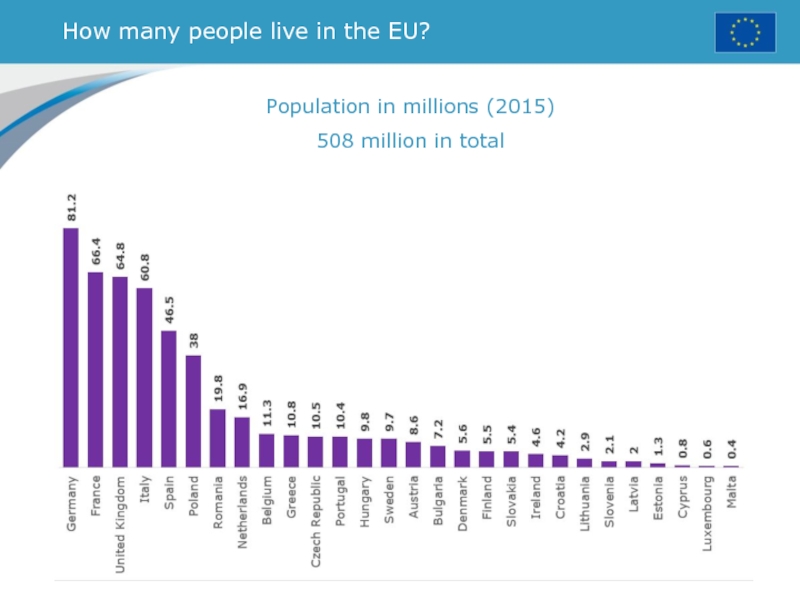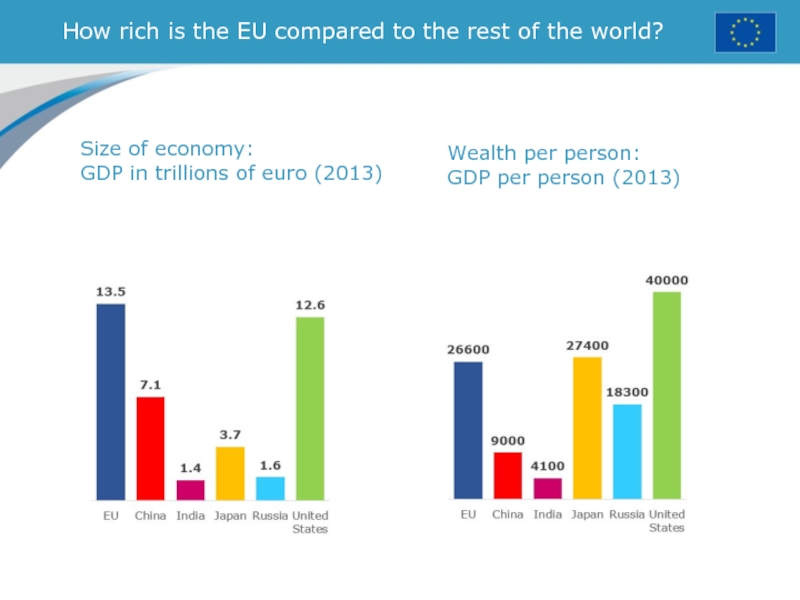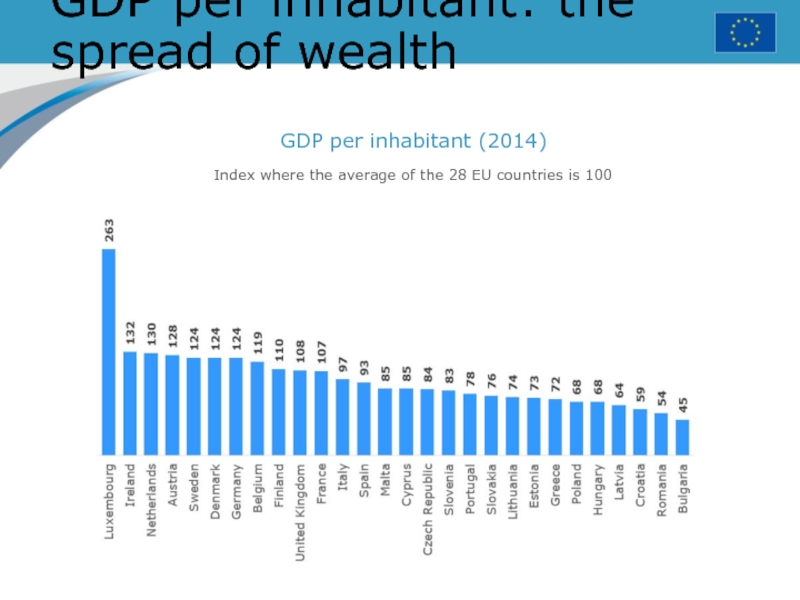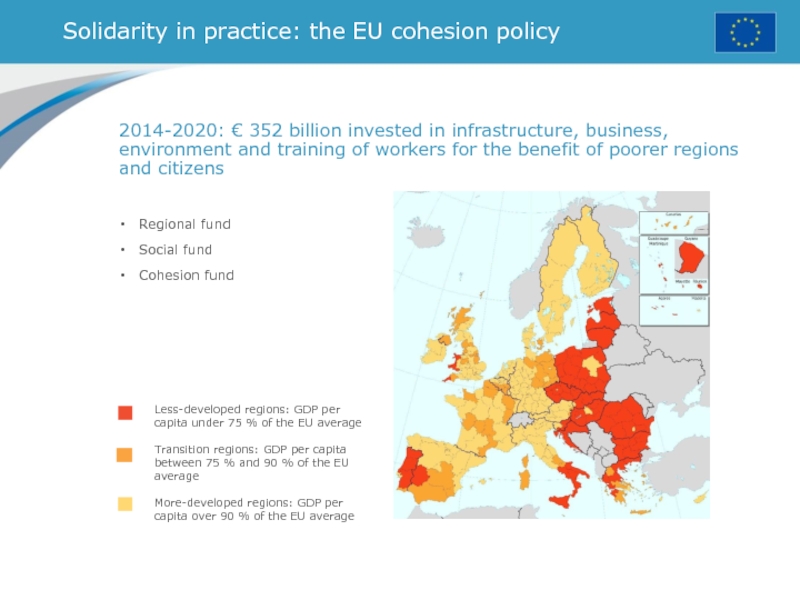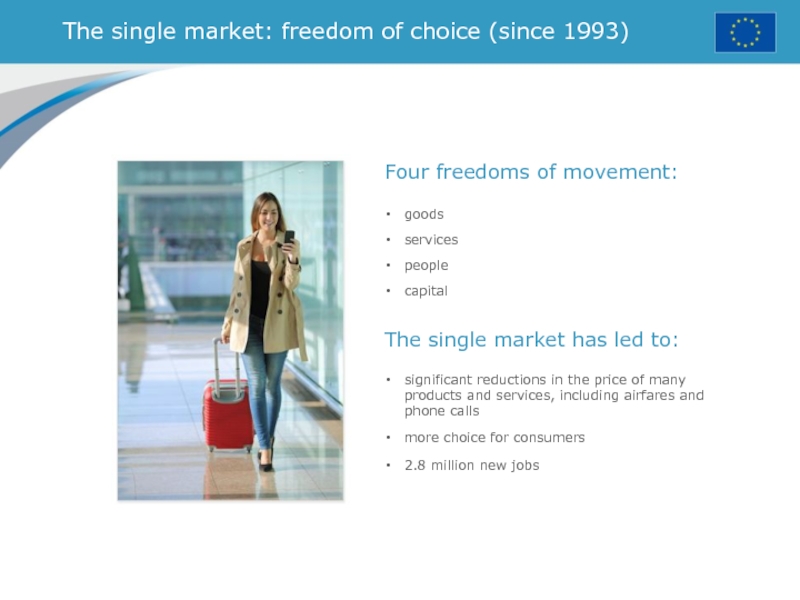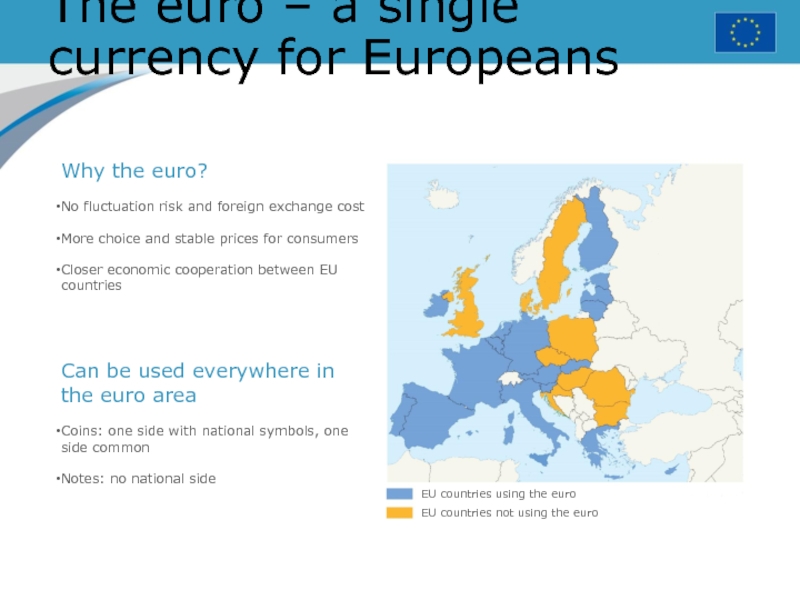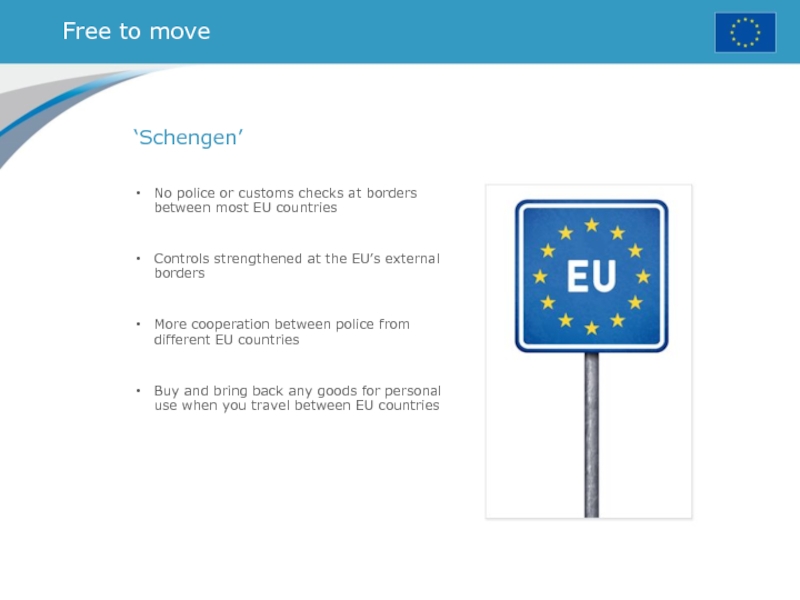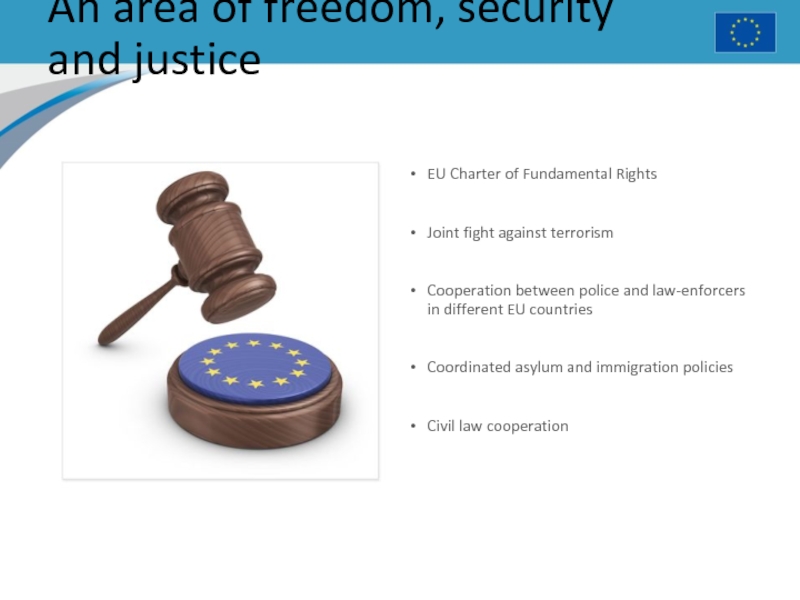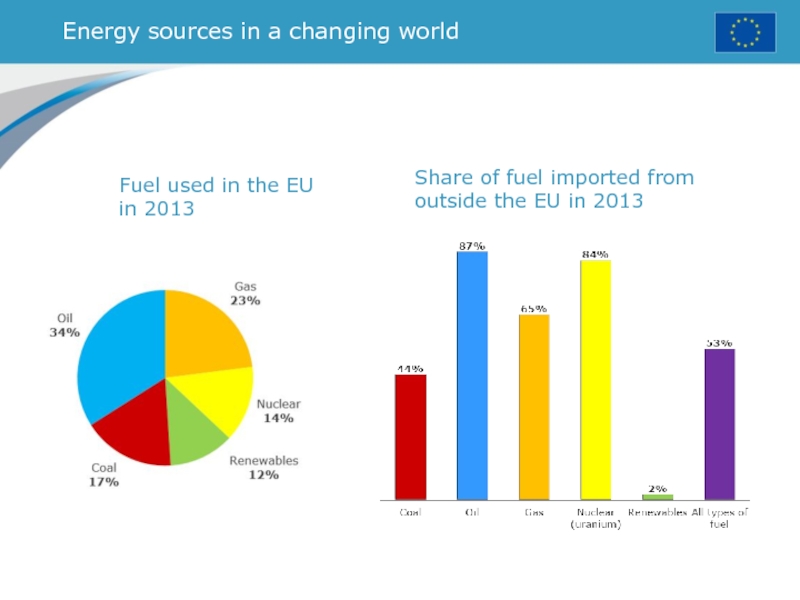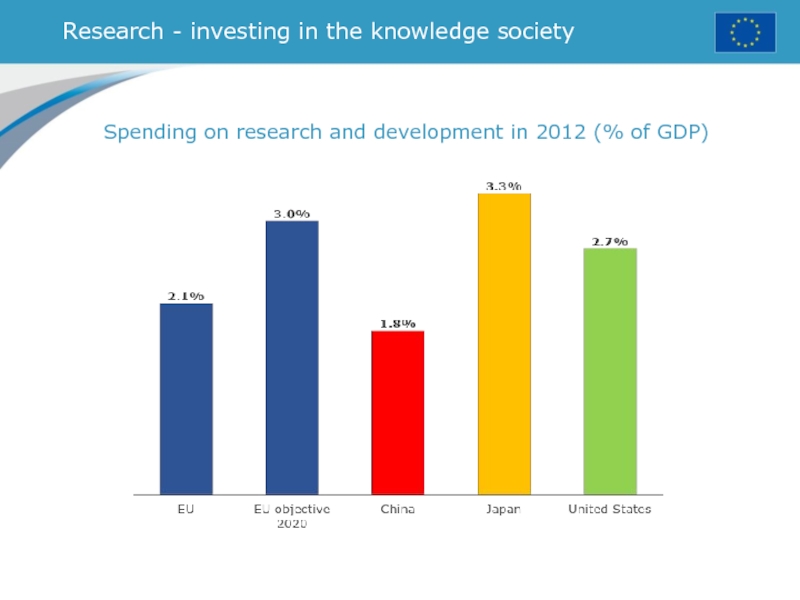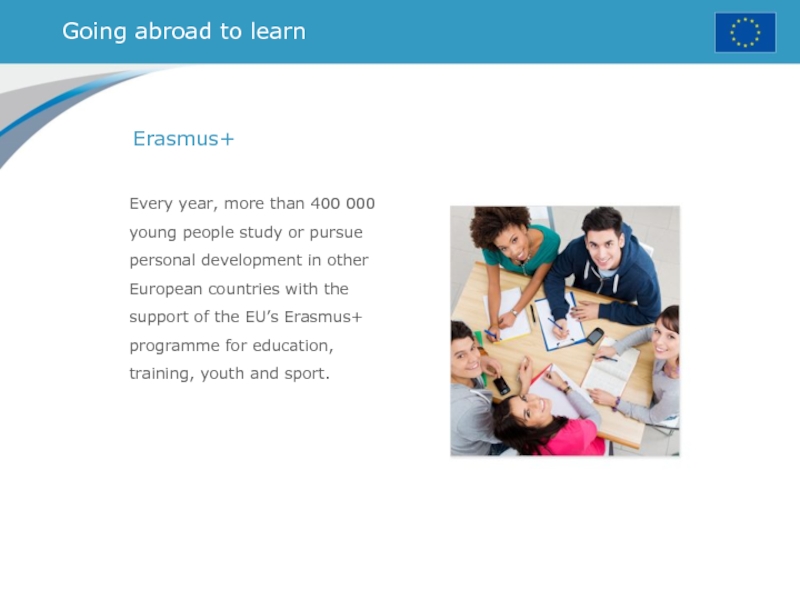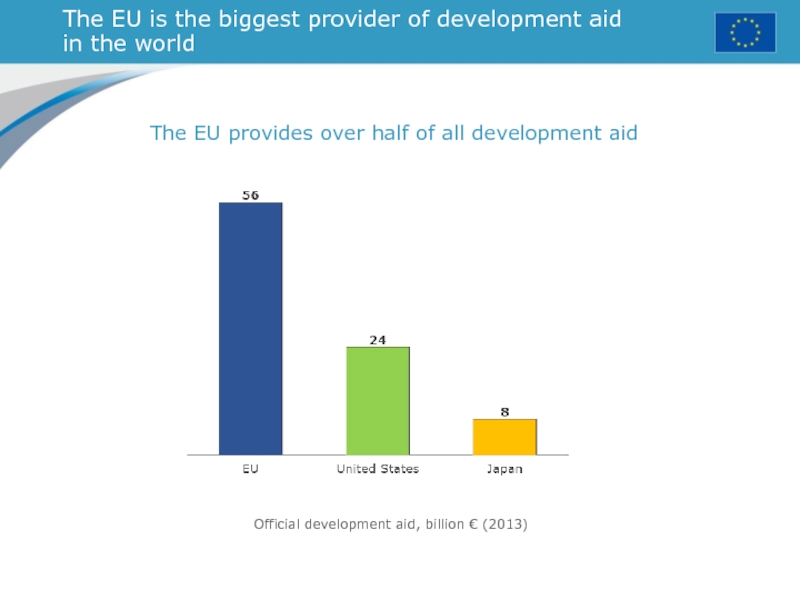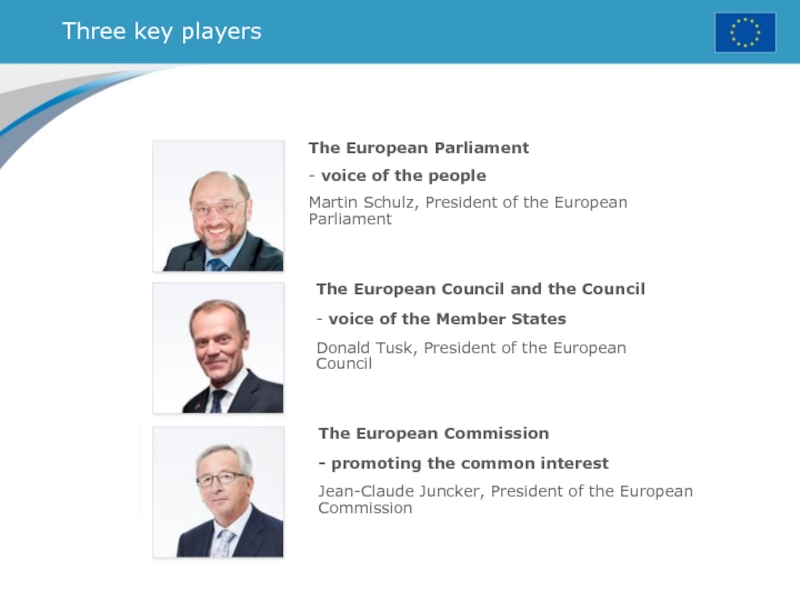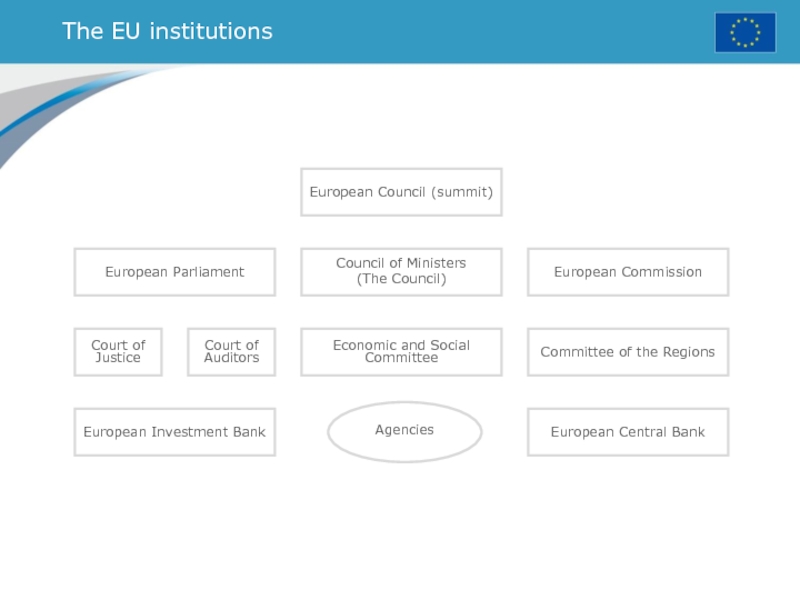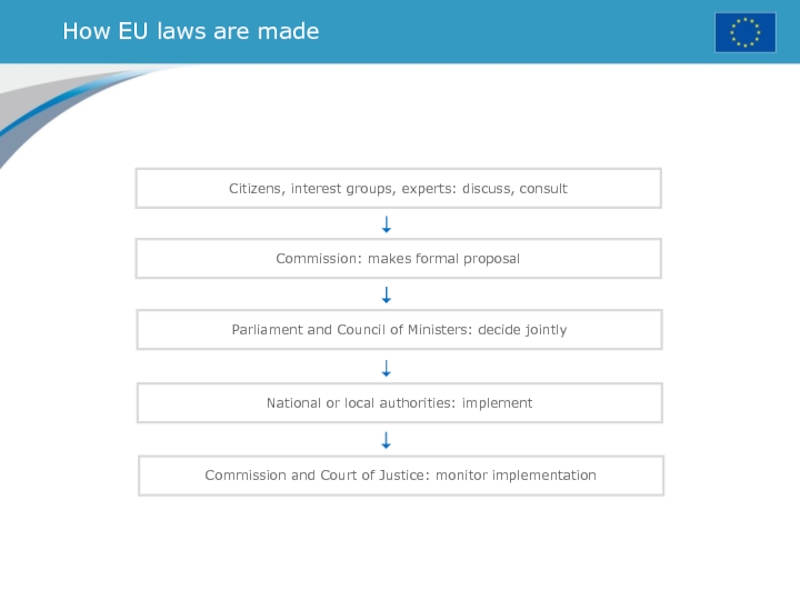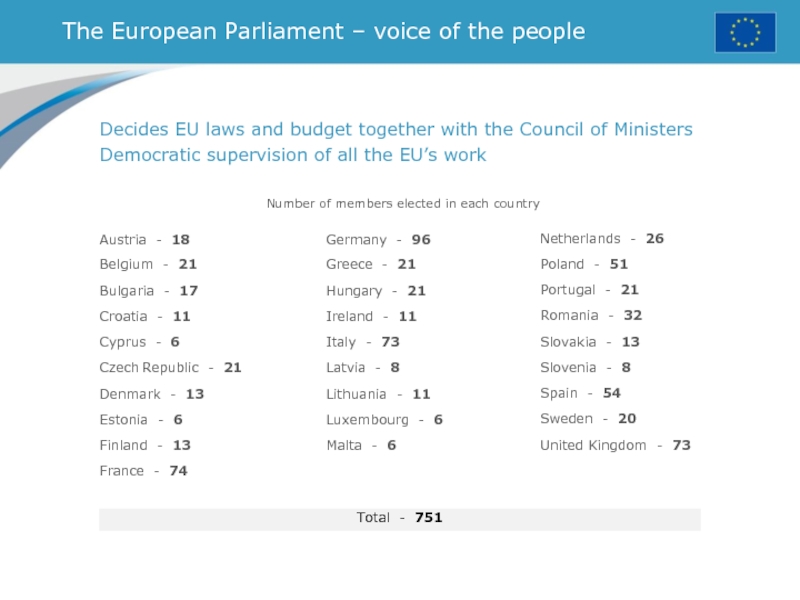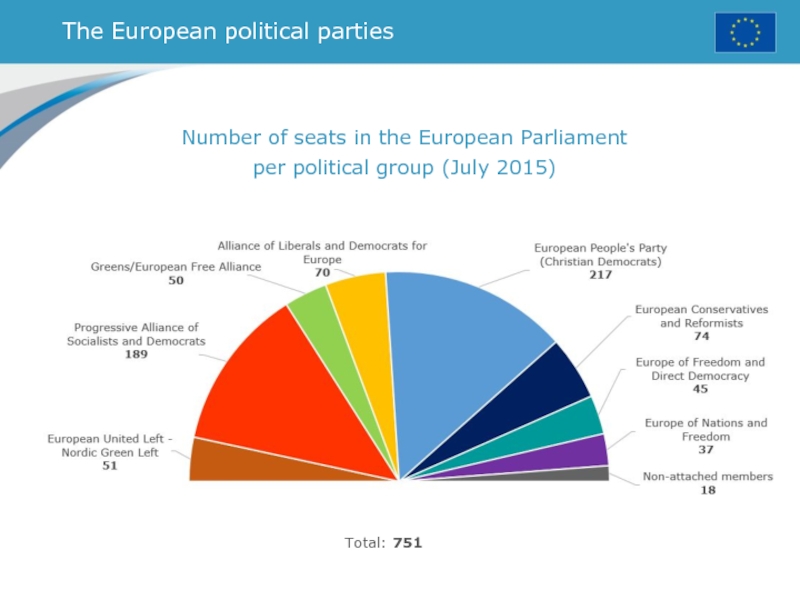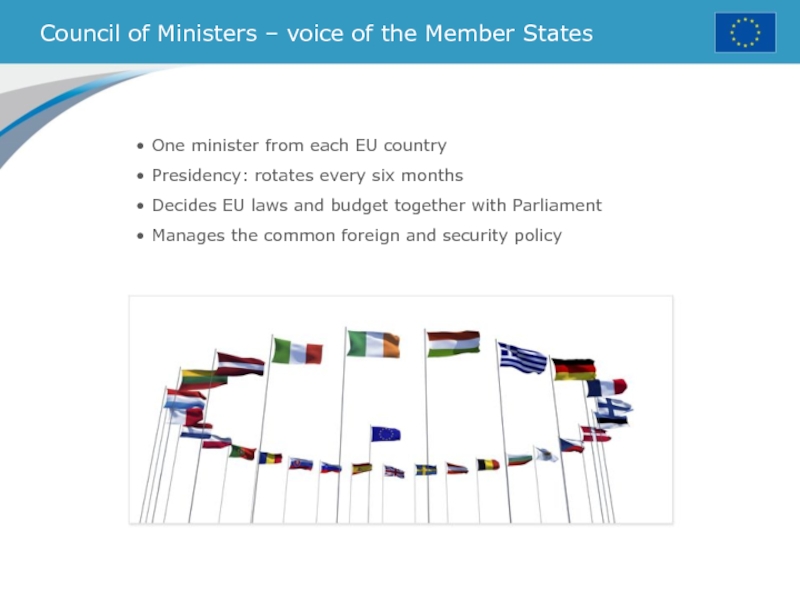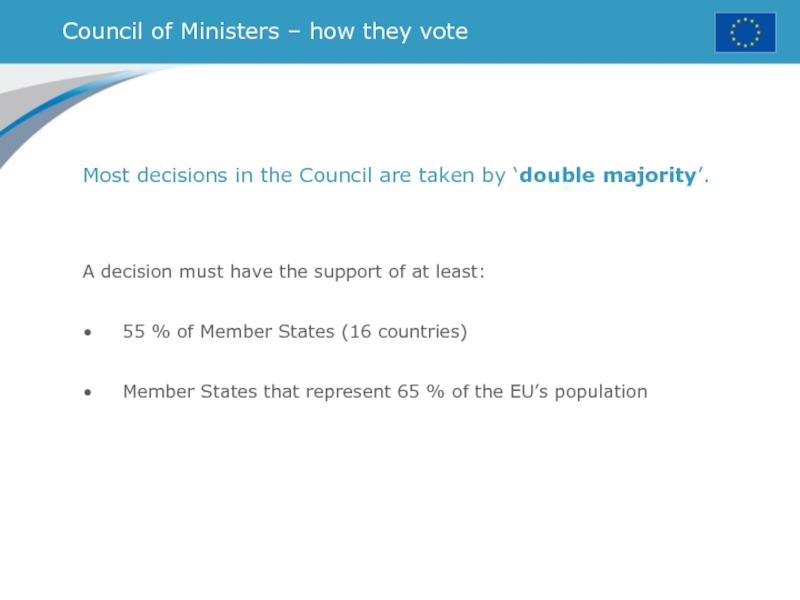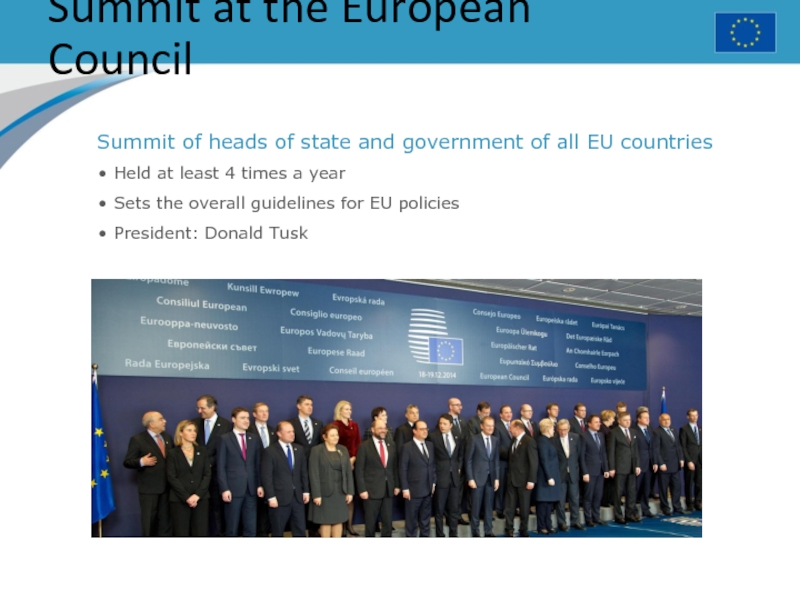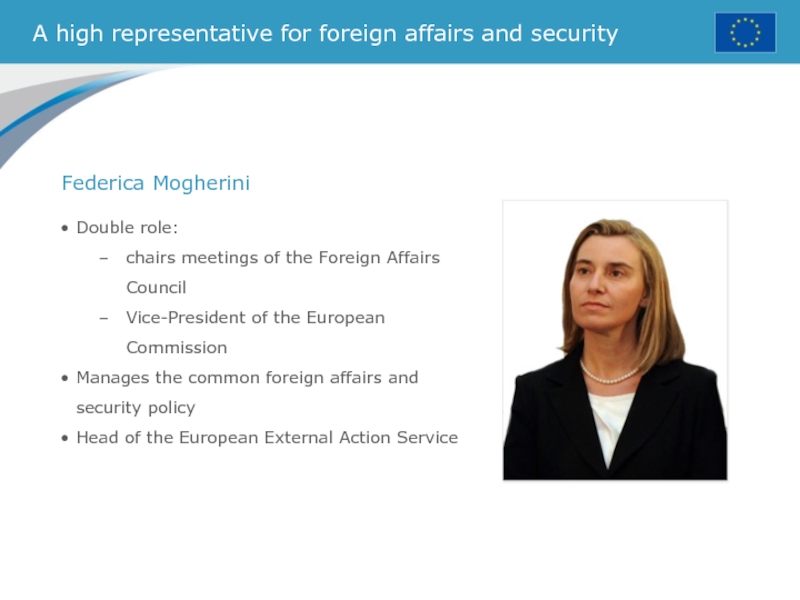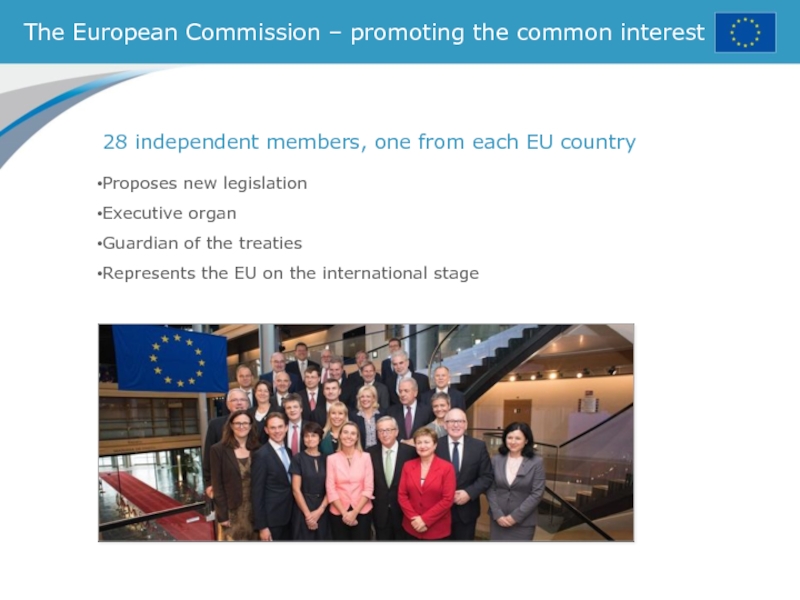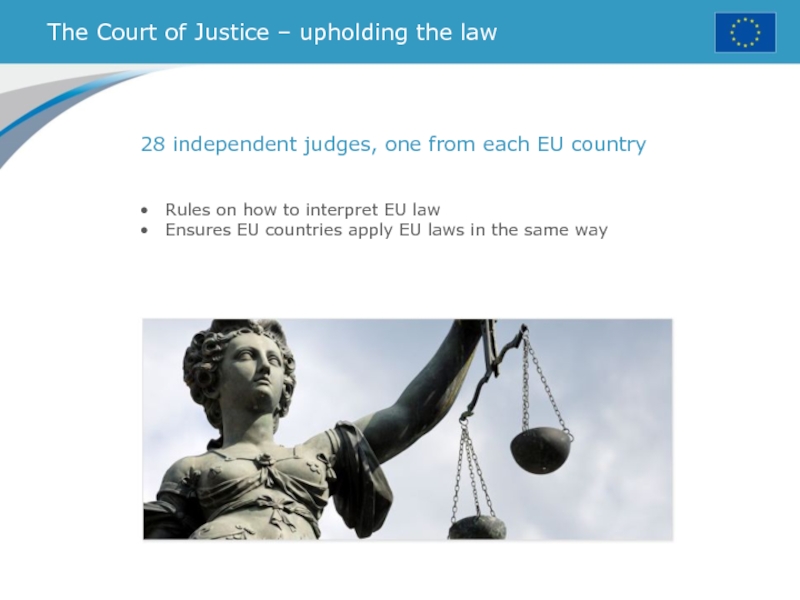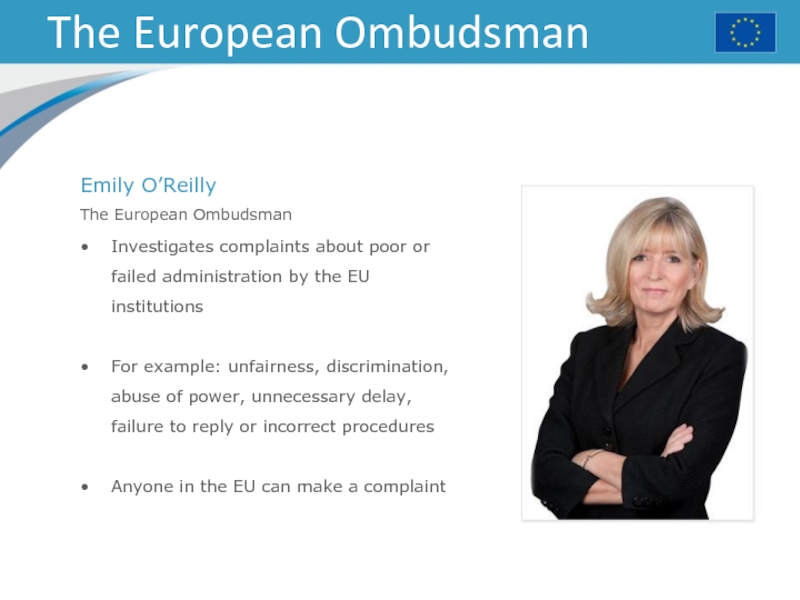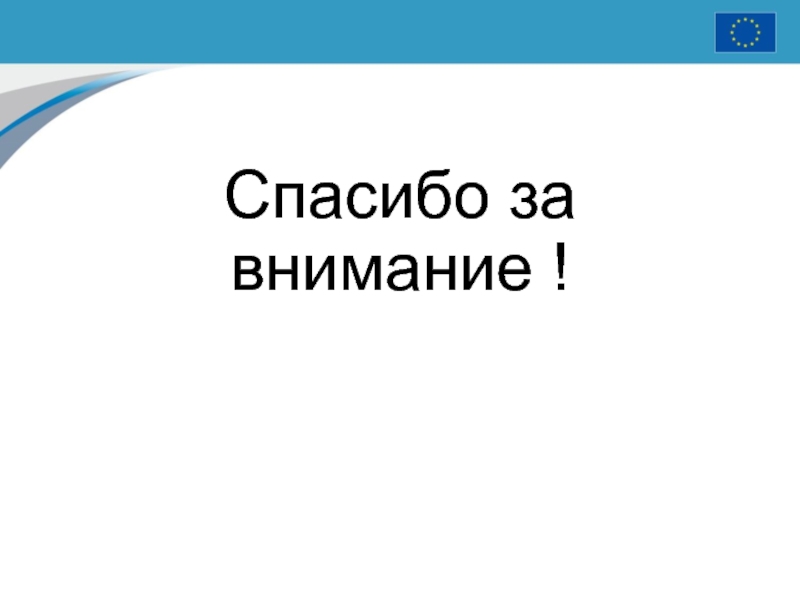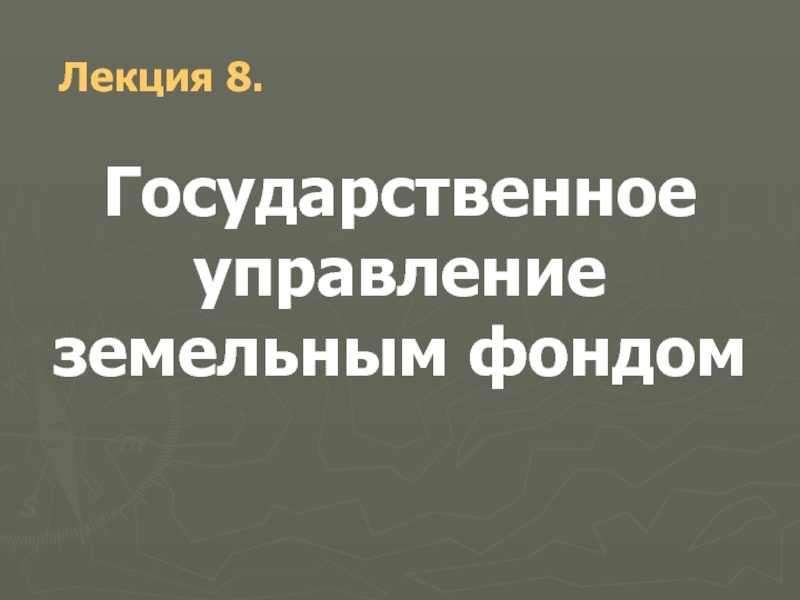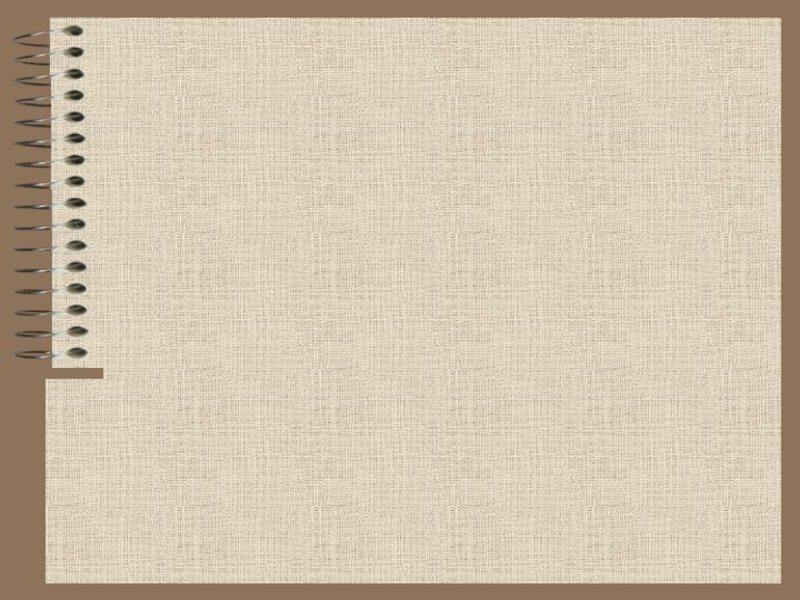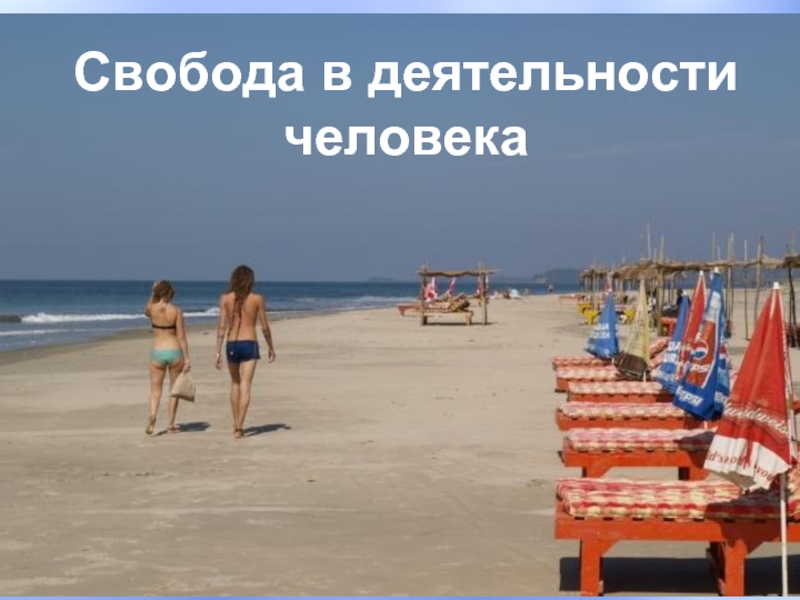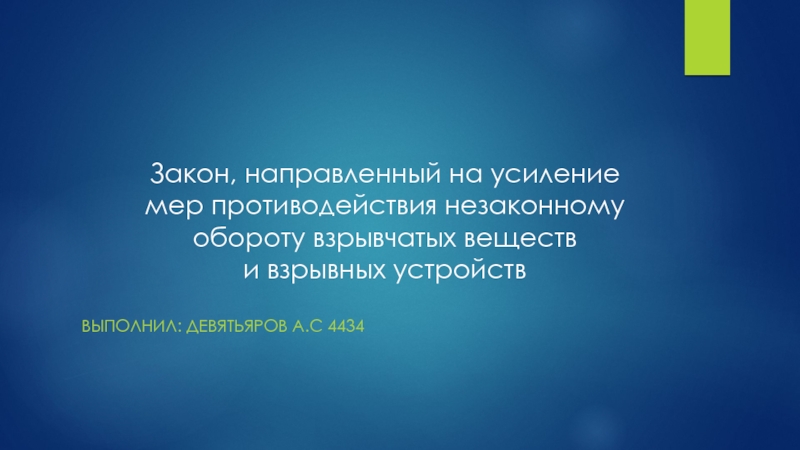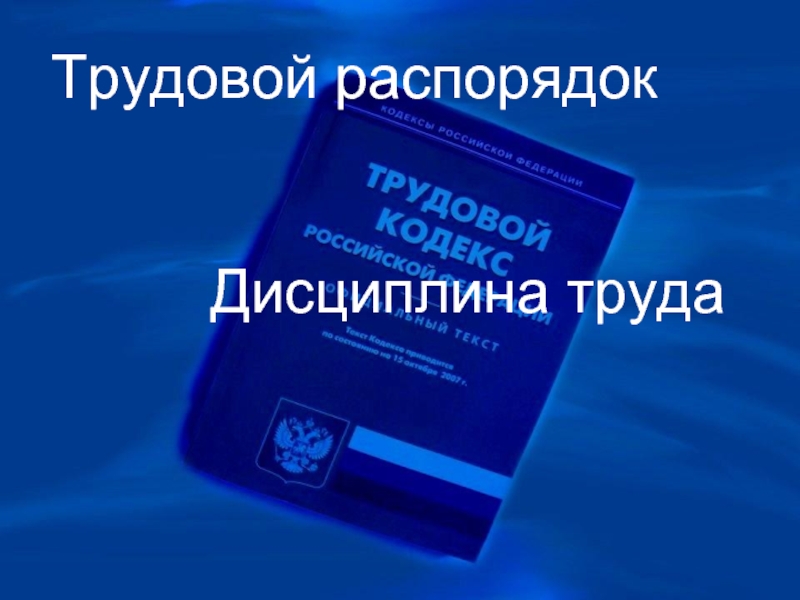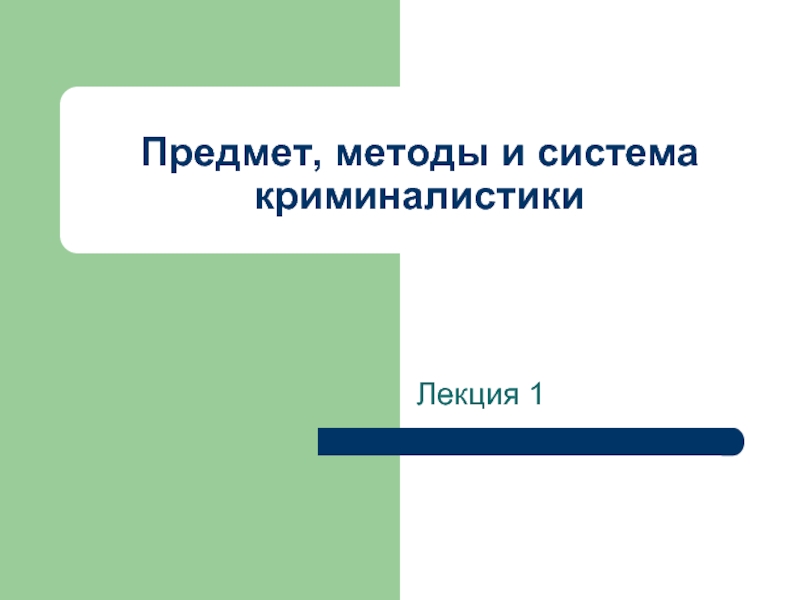- Главная
- Разное
- Дизайн
- Бизнес и предпринимательство
- Аналитика
- Образование
- Развлечения
- Красота и здоровье
- Финансы
- Государство
- Путешествия
- Спорт
- Недвижимость
- Армия
- Графика
- Культурология
- Еда и кулинария
- Лингвистика
- Английский язык
- Астрономия
- Алгебра
- Биология
- География
- Детские презентации
- Информатика
- История
- Литература
- Маркетинг
- Математика
- Медицина
- Менеджмент
- Музыка
- МХК
- Немецкий язык
- ОБЖ
- Обществознание
- Окружающий мир
- Педагогика
- Русский язык
- Технология
- Физика
- Философия
- Химия
- Шаблоны, картинки для презентаций
- Экология
- Экономика
- Юриспруденция
Европейская интеграция и Европейский Союз (ЕС) презентация
Содержание
- 1. Европейская интеграция и Европейский Союз (ЕС)
- 2. The European Union: 500 million people –
- 3. 24 official languages Български Čeština dansk
- 4. The EU symbols The European flag The
- 5. Konrad Adenauer Robert Schuman Winston Churchill Alcide
- 6. Этапы европейской интеграции 9 мая 1950г. -
- 7. Этапы европейской интеграции План Шумана и ЕОУС
- 8. «Каждый человек накапливает свой опыт самостоятельно
- 9. Европейский Союз 9 мая 1950г. - Декларация
- 10. Европейский Союз Европейские сообщества - этапы интеграции
- 11. Европейский Союз Европейские сообщества - этапы интеграции
- 12. Европейский Союз 1997г. Амстердамский договор 2001г. Ниццкий
- 13. The treaties – basis for democratic cooperation
- 14. The EU Charter of Fundamental Rights Binding
- 15. Enlargement: from six to 28 countries
- 16. Европейский Союз Расширения ЕС. ЕС сегодня
- 17. The big enlargement: uniting east and west
- 18. Candidate countries and potential candidates
- 19. EU surface area compared to the rest of the world Surface area (x 1000 km²)
- 20. EU population compared to the rest of the world Population in millions (2015)
- 21. How many people live in the EU?
- 22. How rich is the EU compared to
- 23. GDP per inhabitant: the spread of wealth
- 24. Solidarity in practice: the EU cohesion policy
- 25. The single market: freedom of choice (since
- 26. The euro – a single currency for
- 27. Free to move ‘Schengen’ No police or
- 28. An area of freedom, security and justice
- 29. Energy sources in a changing world Fuel
- 30. Research - investing in the knowledge society
- 31. Going abroad to learn Erasmus+ Every year,
- 32. The EU is the biggest provider of
- 33. Three key players The European Parliament -
- 34. The EU institutions European Parliament Court of
- 35. How EU laws are made Citizens, interest
- 36. The European Parliament – voice of the
- 37. The European political parties Number of seats
- 38. Council of Ministers – voice of the
- 39. Council of Ministers – how they vote
- 40. Summit at the European Council Held at
- 41. A high representative for foreign affairs and
- 42. The European Commission – promoting the common
- 43. The Court of Justice – upholding the
- 44. The European Ombudsman Emily O’Reilly The European
- 45. Спасибо за внимание !
Слайд 2The European Union: 500 million people – 28 countries
Member States of
Candidate countries and potential candidates
Слайд 324 official languages
Български
Čeština
dansk
Deutsch
eesti keel
Ελληνικά
English
español
français
Gaeilge
hrvatski
Italiano
latviešu valoda
lietuvių kalba
magyar
Malti
Nederlands
polski
português
Română
slovenčina
slovenščina
suomi
svenska
Слайд 4The EU symbols
The European flag
The European anthem
The euro
Europe Day, 9 May
The
United in diversity
Слайд 5Konrad Adenauer
Robert Schuman
Winston Churchill
Alcide De Gasperi
Jean Monnet
New ideas for lasting peace
Founders
Слайд 6Этапы европейской интеграции
9 мая 1950г. - Декларация Шумана
Баланс политических, экономических и
Политическое спонсорство США в деле улучшения отношений между Францией и Западной Германией
18 апреля 1951г. – Парижский договор и создание Европейского объединения угля и стали (ЕОУС)
Франция, ФРГ, Бельгия, Нидерланды, Люксембург, Италия
Наднациональность
Правосубъектность сообщества
Договор заключен на 50 лет. Срок действия истек в 2002г. После 2002г. функции ЕОУС перешли к ЕЭС
Отраслевая цель – создание общего рынка угля и стали (создан в 1953г.)
Слайд 7Этапы европейской интеграции
План Шумана и ЕОУС
Институты
Август 1952г. – начало работы Высшего
Право инициативы
Совет министров
Отказ от принципа единогласия
Суд
Парламентская Ассамблея
Принципы
Превосходство институтов
Независимость органов Сообщества
Межинституциональное сотрудничество в рамках единой системы принятия решений
Равенство государств
Слайд 8
«Каждый человек накапливает свой опыт самостоятельно с самого начала. Одни лишь
Жан Монне
Слайд 9Европейский Союз
9 мая 1950г. - Декларация Шумана
1951г. - Европейское объединение угля
Франция, ФРГ, Бельгия, Нидерланды, Люксембург, Италия
Наднациональность
Планы создания Европейского оборонительного сообщества (ЕОС) и их провал (1954)
1955г. Конференция в Мессине. Решение сконцентрироваться на экономических вопросах при развитии планов интеграции
1957г. - создание двух новых сообществ
Европейское экономическое сообщество (ЕЭС)
Европейское сообщество по атомной энергии (Евратом)
Центром интеграционных процессов стало ЕЭС
1965г. Договор о слиянии институтов трех Сообществ
Слайд 10Европейский Союз
Европейские сообщества - этапы интеграции
1. Зона свободной торговли (1957-1968)
сохранении автономии государств в таможенной и торговой политике по отношению к третьим странам
2. Таможенный союз (1968-1987)
введение вместо автономных средств торговой и таможенной политики общего таможенного тарифа и перехода к единой торговой политике в отношении третьих стран
3. Единый внутренний рынок (1987-1992)
свободное движение услуг, капиталов и рабочей силы
Слайд 11Европейский Союз
Европейские сообщества - этапы интеграции
4. Экономический и валютный союз (1992–2002)
введение единой валютной и денежной политики ЕС с заменой национальных валют единой валютой – Евро
1986г. - Единый европейский акт – план перехода к Единому внутреннему рынку
1993г. Маастрихтский договор
Появление Европейского Союза
Европейский Союз
Первая опора - 3 Сообщества (ЕЭС, Евратом, ЕОУС)
Вторая опора - Общая внешняя политика и политика в области безопасности (ОВППБ)
Третья опора - Сотрудничество в области юстиции и внутренних дел
Слайд 12Европейский Союз
1997г. Амстердамский договор
2001г. Ниццкий договор
2004г. Европейский конституционный договор (Европейская конституция)
2005г.
2007г. Лиссабонский договор (Договор о реформе)
1 декабря 2009г. - Лиссабонский договор вступил в силу
Упраздение «опорной» конструкции ЕС
Правосубъектность ЕС
Постоянный председатель Европейского Совета (избирается главами государств и правительств стран-членов ЕС на срок в два с половиной года)
Верховный представитель Союза по иностранным делам и политике безопасности
European External Action Service (Европейская служба внешнеполитических действий)
Слайд 13The treaties – basis for democratic cooperation built on law
The European
The treaties of Rome:
• The European Economic Community
• The European Atomic Energy Community
(EURATOM)
The European Single Act: the Single Market
Treaty on European Union - Maastricht
Treaty of Amsterdam
1952
1958
1987
1993
1999
2003
Treaty of Nice
2009
Treaty of Lisbon
Слайд 14The EU Charter of Fundamental Rights
Binding for all the EU's activities
54
Freedoms
Equality
Solidarity
Citizens’ rights
Justice
Dignity
Слайд 16Европейский Союз
Расширения ЕС. ЕС сегодня - это 28 стран-членов
Страны-учредители: Франция,
1973г. - Великобритания, Дания, Ирландия
1981г. - Греция
1986г. - Испания, Португалия
1995г. Швеция, Финляндия, Австрия
2004г. Эстония, Латвия, Литва, Польша, Чехия, Словакия, Венгрия, Словения, Кипр, Мальта
2007г. - Болгария, Румыния
2013г. - Хорватия
На сегодняшний день ЕС рассматривает как кандидатов на вступление Македонию, Черногорию, Сербию, Албанию и Турцию
ЕС также рассматривает как потенциальных кандидатов на вступление Боснию и Косово (частично признанное государство )
Слайд 17The big enlargement: uniting east and west
Fall of Berlin Wall –
EU economic help begins: Phare programme
Criteria set for a country to join the EU:
• democracy and rule of law
• functioning market economy
• ability to implement EU laws
Formal negotiations on enlargement begin
Copenhagen summit agrees to a big enlargement of 10 new countries
Ten new EU members: Cyprus, Czech Republic, Estonia, Hungary, Latvia, Lithuania, Malta, Poland, Slovakia, Slovenia
1989
1992
1998
2002
2004
2007
Bulgaria and Romania join the EU
2013
Croatia joins on 1 July
Слайд 22How rich is the EU compared to the rest of the
Size of economy:
GDP in trillions of euro (2013)
Wealth per person:
GDP per person (2013)
Слайд 23GDP per inhabitant: the spread of wealth
GDP per inhabitant (2014)
Index where
Слайд 24Solidarity in practice: the EU cohesion policy
Regional fund
Social fund
Cohesion fund
Less-developed
Transition regions: GDP per capita between 75 % and 90 % of the EU average
More-developed regions: GDP per capita over 90 % of the EU average
2014-2020: € 352 billion invested in infrastructure, business, environment and training of workers for the benefit of poorer regions and citizens
Слайд 25The single market: freedom of choice (since 1993)
The single market has
significant reductions in the price of many products and services, including airfares and phone calls
more choice for consumers
2.8 million new jobs
Four freedoms of movement:
goods
services
people
capital
Слайд 26The euro – a single currency for Europeans
EU countries using
EU countries not using the euro
Why the euro?
No fluctuation risk and foreign exchange cost
More choice and stable prices for consumers
Closer economic cooperation between EU countries
Can be used everywhere in the euro area
Coins: one side with national symbols, one side common
Notes: no national side
Слайд 27Free to move
‘Schengen’
No police or customs checks at borders between most
Controls strengthened at the EU’s external borders
More cooperation between police from different EU countries
Buy and bring back any goods for personal use when you travel between EU countries
Слайд 28An area of freedom, security and justice
EU Charter of Fundamental Rights
Joint
Cooperation between police and law-enforcers in different EU countries
Coordinated asylum and immigration policies
Civil law cooperation
Слайд 29Energy sources in a changing world
Fuel used in the EU in
Share of fuel imported from outside the EU in 2013
Слайд 30Research - investing in the knowledge society
Spending on research and development
Слайд 31Going abroad to learn
Erasmus+
Every year, more than 400 000 young people
Слайд 32The EU is the biggest provider of development aid in the
The EU provides over half of all development aid
Official development aid, billion € (2013)
Слайд 33Three key players
The European Parliament
- voice of the people
Martin Schulz, President
The European Council and the Council
- voice of the Member States
Donald Tusk, President of the European Council
The European Commission
- promoting the common interest
Jean-Claude Juncker, President of the European Commission
Слайд 34The EU institutions
European Parliament
Court of Justice
Court of Auditors
Economic and Social Committee
Committee
Council of Ministers
(The Council)
European Commission
European Investment Bank
European Central Bank
Agencies
European Council (summit)
Слайд 35How EU laws are made
Citizens, interest groups, experts: discuss, consult
Commission: makes
Parliament and Council of Ministers: decide jointly
National or local authorities: implement
Commission and Court of Justice: monitor implementation
Слайд 36The European Parliament – voice of the people
Number of members elected
Decides EU laws and budget together with the Council of Ministers
Democratic supervision of all the EU’s work
Austria - 18
Belgium - 21
Bulgaria - 17
Croatia - 11
Cyprus - 6
Czech Republic - 21
Denmark - 13
Estonia - 6
Finland - 13
France - 74
Germany - 96
Greece - 21
Hungary - 21
Ireland - 11
Italy - 73
Latvia - 8
Lithuania - 11
Luxembourg - 6
Malta - 6
Total - 751
Netherlands - 26
Poland - 51
Portugal - 21
Romania - 32
Slovakia - 13
Slovenia - 8
Spain - 54
Sweden - 20
United Kingdom - 73
Слайд 37The European political parties
Number of seats in the European Parliament
per
Total: 751
Слайд 38Council of Ministers – voice of the Member States
One minister from
Presidency: rotates every six months
Decides EU laws and budget together with Parliament
Manages the common foreign and security policy
Слайд 39Council of Ministers – how they vote
Most decisions in the Council
A decision must have the support of at least:
• 55 % of Member States (16 countries)
• Member States that represent 65 % of the EU’s population
Слайд 40Summit at the European Council
Held at least 4 times a year
Sets
President: Donald Tusk
Summit of heads of state and government of all EU countries
Слайд 41A high representative for foreign affairs and security
Double role:
chairs meetings
Vice-President of the European Commission
Manages the common foreign affairs and security policy
Head of the European External Action Service
Federica Mogherini
Слайд 42The European Commission – promoting the common interest
28 independent members, one
Proposes new legislation
Executive organ
Guardian of the treaties
Represents the EU on the international stage
Слайд 43The Court of Justice – upholding the law
28 independent judges, one
Rules on how to interpret EU law
Ensures EU countries apply EU laws in the same way
Слайд 44The European Ombudsman
Emily O’Reilly
The European Ombudsman
Investigates complaints about poor or failed
For example: unfairness, discrimination, abuse of power, unnecessary delay, failure to reply or incorrect procedures
Anyone in the EU can make a complaint
